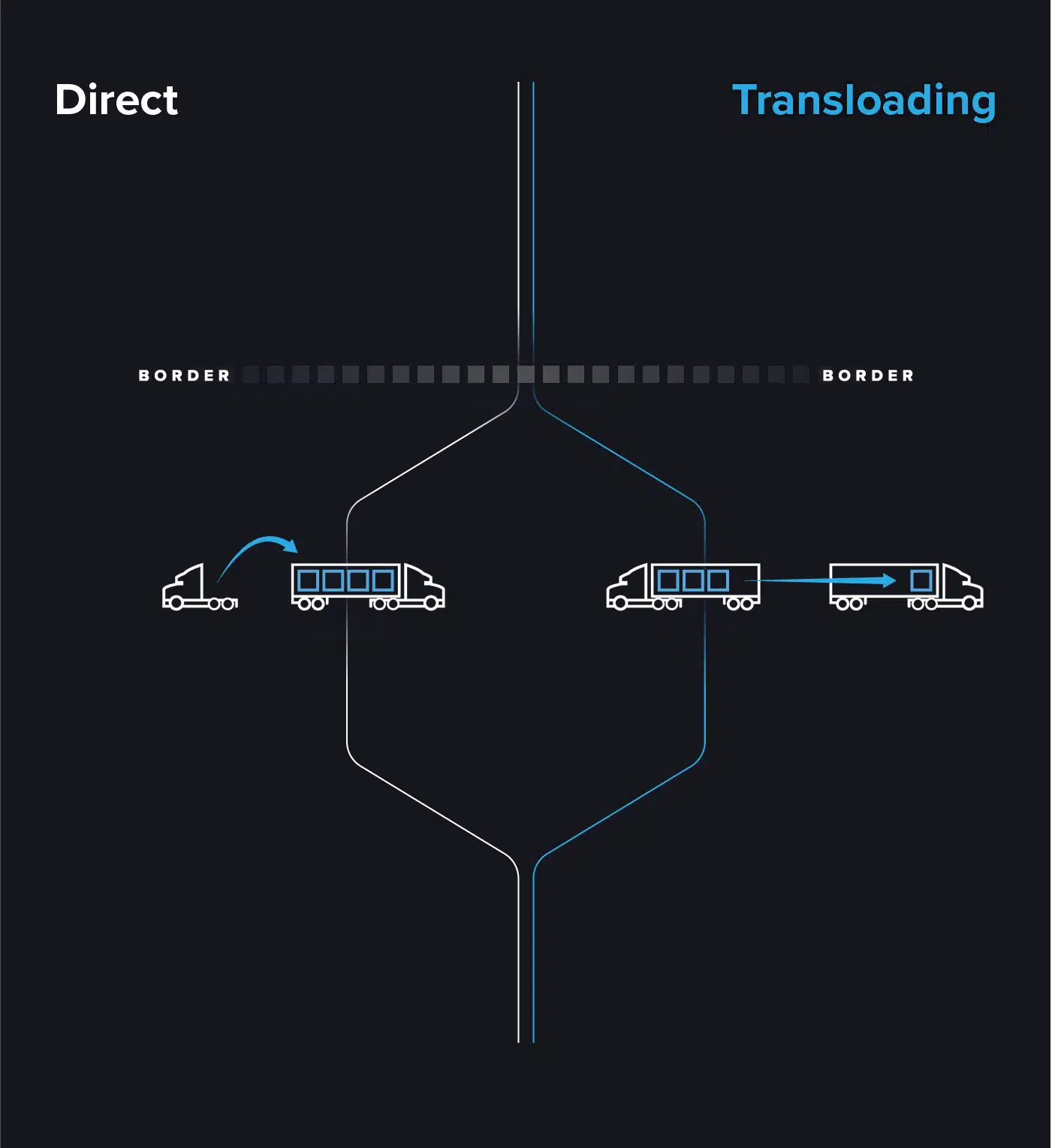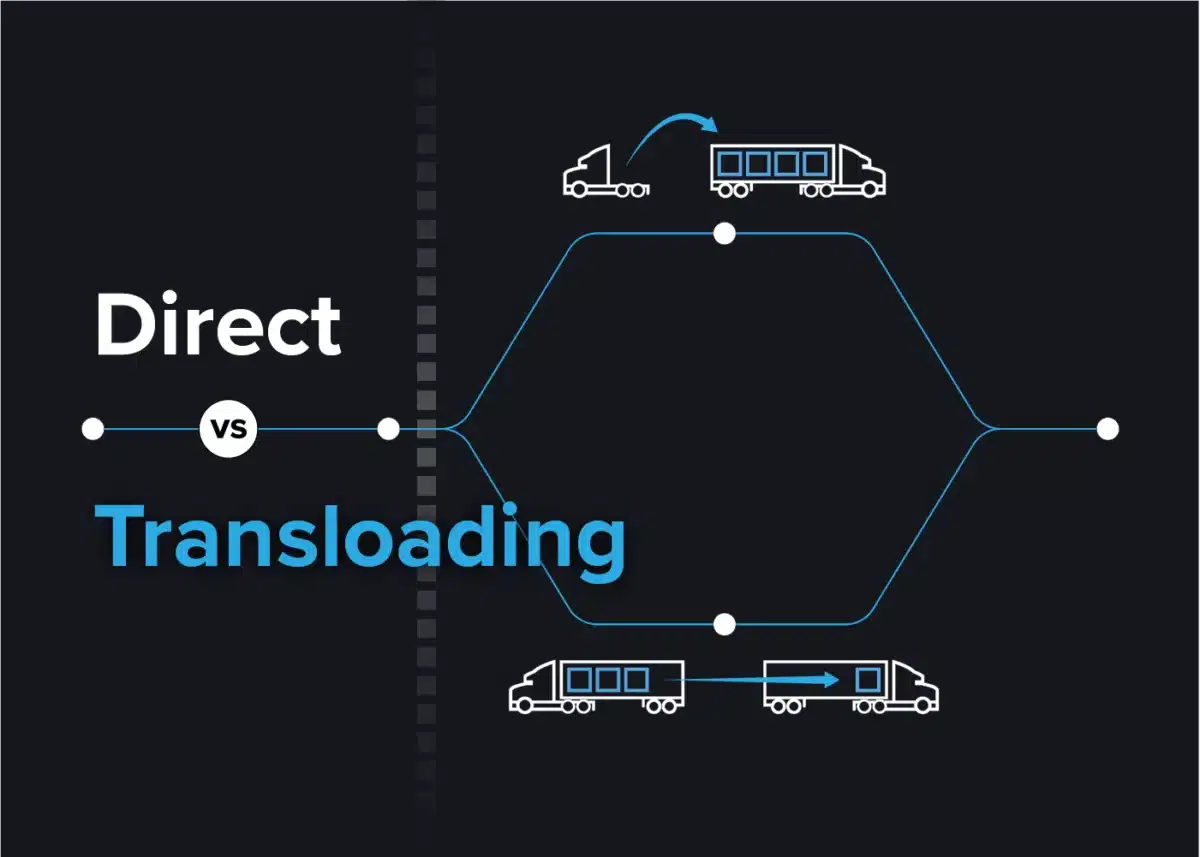
"*" indicates required fields
"*" indicates required fields
"*" indicates required fields

Choosing between direct shipping and transloading is one of many variables to consider when moving freight across the U.S.-Mexico border because it significantly influences transportation costs and shipment flexibility.
Most cross-border service providers offer both options, so understanding the difference will help you choose the right partner based on your unique freight needs and business goals.
Direct shipping — which is also known as door-to-door or through-trailer — means goods stay in their original trailer when crossing the border. As a result, up to two or three different drivers are typically required to haul the trailer from origin to destination.
Direct shipping carriers have a trailer interchange agreement between parties hauling freight on each side of the border, allowing the same load to move freely even as the trailer changes hands. While a perfectly effective approach, direct shipping can often limit your carrier options and drive up rates in turn.
Transloading, on the other hand, means your freight is taken to a specialized facility and transferred to a different trailer when it crosses the border. These transfers typically take place on the U.S. side of the border to ensure product integrity and security.
Transloading offers access to a larger carrier network, which translates to more capacity, improved pricing, and greater visibility into and control over the entire process.
Below is a visual example of how freight moves from Mexico to the United States using both approaches.
Hover to reveal step description.

Mexico carrier picks
up freight from the
shipping facility.
Mexico carrier drops
off the trailer at the
Mexico border yard.
Mexico drayage carrier takes
the trailer across
the border.
Mexico drayage carrier
drops off the trailer
at the U.S. partner
carrier’s yard.
U.S. transloading facility
transfers the freight to a
U.S. carrier trailer.
U.S. carrier takes the
trailer and completes
the delivery.
As you can see, the number of touch points doesn’t change, but where the trailer stops and who’s responsible for it does. It is also worth noting that while shipping “direct” might sound faster, both processes actually take the same amount of time.
There are three key variables to consider when determining whether direct shipping or transloading is best for your freight.
The type of freight will often determine whether direct or transloading is the optimal approach.
Transloading is generally best for any palletized or packaged freight moved with a forklift, such as food and beverage, automotive, and consumer packaged goods.
Direct shipping is typically the only option for flatbed, oversized, or heavy products. This freight often requires specialized loading capabilities, so it’s important (and easier) to keep it in one trailer for the duration of the trip.
Transloading is typically the most affordable way to move freight across the border because it utilizes the full capacity of two carrier bases — one in Mexico and one in the United States.
For example, when transloading with Arrive Logistics, you’re tapping into a network of more than 70,000 carriers that move hundreds of loads to and from border cities. More carriers means increased competition for loads, which will drive down rates on many cross-border lanes.
Conversely, shipping direct requires carriers with an interchange agreement, which limits carrier options and increases costs — you’re also often stuck paying a premium to reduce freight handling, adding to the overall price.
If your freight can be transloaded, handling shouldn’t impact your decision much.
Transloading facilities have skilled teams for moving freight from one trailer to another, and specialized cross-border logistics companies like Arrive develop strong relationships with these facilities to ensure they handle your freight with care.
Direct shipping minimizes handling but doesn’t eliminate it. All freight that stops at the border is subject to inspection, which means even pallets can be unloaded and put at risk for damage during a check by customs agents.
Your freight, financial goals, and business strategy will ultimately determine whether direct shipping or transloading is the right solution for your business. Still, making that decision, let alone executing the shipments, can be overwhelming, so choosing the right partner will pay dividends.
Our experts have the experience, expertise, and international carrier network to transport your cross-border freight safely and cost-effectively. Click here to learn how we can deliver for you.

